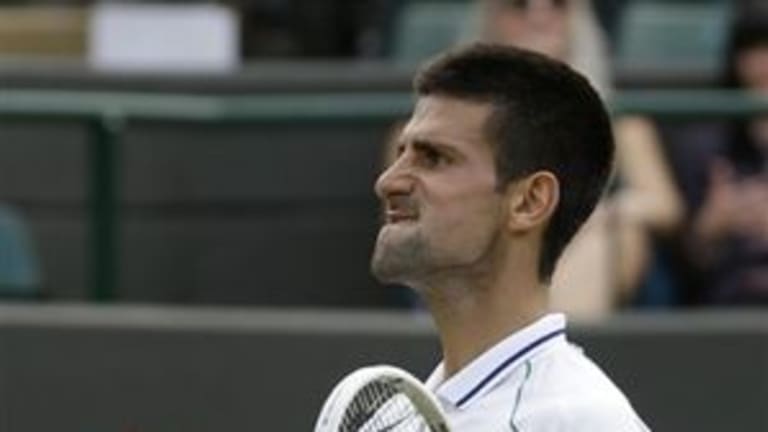If Novak Djokovic wanted to make sure he was ready for anything in his upcoming semifinal with Roger Federer, he couldn’t have asked for a better opponent that Florian Mayer. While the 6-4, 6-1, 6-4 score was routine, the match was hardly straightforward.
The German is a proverbially “tricky” opponent who rarely does the expected. Today he showed Djokovic his full arsenal of oddities. There was the scoop forehand lob. There was the jumping backhand pass while running backward. There was the two-handed sidespin backhand. There was the mid-air drop shot. Few players with two-handed backhands have ever had the idiosyncratic variety of Mayer.
And for five games, it worked. Mayer broke Djokovic at 2-2 in the first set, with a stinging backhand down the line on one point, and another stinger from the forehand side on the next point. Mayer, among his other tricks, is adept at changing speeds, and he can generate a deceptive amount of pace with his flat two-hander. Djokovic was caught off guard by that pace early.
But he adjusted quickly, and broke Mayer back right away. Still, Djokovic was off-kilter enough to remain tight through the rest of the first set. He went down 0-40 on his serve at 4-4. If there was a key point in the match, it was this one. Mayer approached the net and got a high forehand volley. Rather than angle it into the open court, he tried to go behind Djokovic. The Serb recovered backward just in time to block a backhand pass onto the sideline for a winner.
From there, you could feel the match’s momentum change with each point in that game. Djokovic began to step forward on his forehand, while Mayer grew tentative. On his last break point, at 30-40, he put a regulation backhand feebly into the net. Two points later, Djokovic hit another backhand pass to hold. The German’s head hung, while the Serb skipped off to the sideline with new energy. It was hardly a surprise when Mayer threw in three easy errors in the next game and was broken for the set.
That was the beginning of the end. The nail in the coffin came three games later. With Mayer serving at 1-2, the two played a grueling point that left Mayer doubled over. He never recovered. Djokovic broke with a forehand pass on the next point and ran out the set without losing another game.
The third was more competitive. Djokovic saved a break point with a service winner at 3-4, and then visibly dialed himself in and broke with another forehand pass at 4-4. Surprisingly, he tightened up while serving it out, and was forced to save three break points, but he did it in style, closing with his seventh ace.
Djokovic served decently—65 percent of first balls in, a winning percentage of 76 on those points—and was clean from the baseline. He hit 50 winners against 20 unforced errors, and won 45 percent of his returning points. He was never seriously threatened by Mayer, who, when it mattered, was as ineffective as he was flashy. The pensive, diffident German was 1 of 8 on break points, and came up with just 14 winners against 17 errors.
The latter stat, of course, is a testament to Djokovic’s brilliant defense—he was, as usual, everywhere, and was especially good with his running forehand crosscourt pass. I’m going to go out on a limb and say that’s a shot we’ll see at least once in his next match, against another flashy, but infinitely more effective, opponent.
